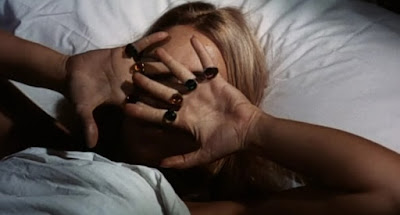An art-horror oddity from Spain, The Blood Spattered Bride is a loose adaptation of Irish author Sheridan Le Fanu's famous vampire novella Carmilla. A work that predated Stoker's Dracula by 26 years, Carmilla has inspired several stories, novels, films, songs, and television episodes. Aranda's 1972 take on the source material is fascinating, weird, and full of memorable images, but it can also be pretentious and silly, and Aranda sends a lot of mixed messages by bouncing back and forth between morality tale, leering exploitation film, and atmospheric mood piece. It's a confused but potent mix, and I ended up liking it more than I disliked it.
About those mixed messages. Aranda's film shares with Le Fanu's source material a simultaneous erotic fascination with lesbianism and a "moral" aversion to it. The film rebukes Spanish machismo and the stupid and grotesque parts of masculinity in several sharp, funny scenes, but Aranda's camera also lingers on and leers up and down his actresses' bodies. And he interrupts his atmospheric approach to horror a few times to drown the frame in buckets of blood. This is a criticism, in part, but it's also an interested observation. Human lives are filled with contradictions and hypocrisies and confusions and the particular strains of ignorance prevalent in whichever historical and cultural moment we find ourselves in, and so are the movies.
The Blood Spattered Bride opens with newlyweds Susan (Maribel Martin) and her never-named husband (Simon Andreu) arriving at a fancy hotel for their first night of marriage. Susan is a virgin, and she convinces Husband to leave the hotel after a vivid nightmare/hallucination of a man who looks exactly like him jumping out of a closet and strangling her and molesting her corpse. Husband, who is a jobless wealthy heir to an aristocratic family, moves her into the family home, currently occupied by a pair of married servants (Angel Lombarte and Montserrat Julio) and their twelve-year-old daughter Carol (Rosa Rodriguez). Carol is mostly silent and mysterious, with a demeanor that seems both older and younger than twelve.
Husband doesn't waste any time being a jerk, tearing Susan's wedding dress off her and constantly wanting sex and pulling her hair and treating her like a child when she tries to talk to him about her vivid nightmares, but she soon starts standing up for herself and finding ways to pierce his unearned confidence. The nightmares increase in power and intensity, though, and much is made of a gnarly looking dagger that keeps appearing and reappearing, even after Husband repeatedly hides it. He thinks his wife is hysterical and childish, and he enlists a doctor friend to inject her with sedatives and generally double the sexism and condescension around the house.
There's also the matter of the family portraits. Only the men's portraits are hanging in the house, with the women's chucked in the cellar, including a strange portrait missing its face that shows a blood-streaked woman's body in a wedding dress holding a dagger. You know, normal shit. Could it be the woman who keeps appearing to Susan in both her dreams and strange, fleeting moments while she's awake? And what happens when Husband finds a nude woman buried in sand, wearing a snorkel, on the beach and brings her back to the house to recuperate when she refuses help from the police, in a bonkers scene? Possible spoiler alert: maybe she's a vampire and the one from the dreams and the faceless portrait.
As you can tell, there's a lot going on in this movie, and Aranda finds so many great ways to tell this story visually, even when the screenplay and dialogue lag behind. There's a dreamy, hypnotic quality to the images, and Aranda finds a poetic way to frame shots about women having to deal with stupid, overbearing, and controlling men. (Though he also throws in a ton of gratuitous nudity.) The slow emergence of the vampire part of the story helped to ever so gradually increase the feeling of dread. My wife pointed out, though, that the film's first half mostly places us within Susan's point of view, while the second half detaches that perspective to focus on the plot, which is a little jarring. The images remain powerful, however, especially a too-brief shot of Susan and the mystery woman walking into the woods at night. The Blood Spattered Bride is a mixed bag, for sure, but one worth seeing. It's easy to understand why this became a cult film.
Saturday, December 8, 2018
Subscribe to:
Post Comments (Atom)









No comments:
Post a Comment